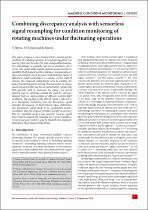 ResearchSpace
ResearchSpace
Combining discrepancy analysis with sensorless signal resampling for condition monitoring of rotating machines under fluctuating operations
JavaScript is disabled for your browser. Some features of this site may not work without it.
- ResearchSpace
- →
- Research Publications/Outputs
- →
- Journal Articles
- →
- View Item
| dc.contributor.author |
Heyns, T

|
|
| dc.contributor.author |
Heyns, PS

|
|
| dc.contributor.author |
Zimroz, R

|
|
| dc.date.accessioned | 2013-03-25T06:45:36Z | |
| dc.date.available | 2013-03-25T06:45:36Z | |
| dc.date.issued | 2012-12 | |
| dc.identifier.citation | Heyns, T, Heyns, PS and Zimroz, R. 2012. Combining discrepancy analysis with sensorless signal resampling for condition monitoring of rotating machines under fluctuating operations. The International Journal of Condition Monitoring, vol. 2(2), pp 52-58(7) | en_US |
| dc.identifier.uri | http://www.ingentaconnect.com/content/bindt/ijcm/2012/00000002/00000002/art00004 | |
| dc.identifier.uri | http://hdl.handle.net/10204/6605 | |
| dc.description | Copyright: 2012 The British Institute of Non-Destructive Testing. Published in The International Journal of Condition Monitoring, vol. 2(2), pp 52-58(7) | en_US |
| dc.description.abstract | This paper proposes a novel framework for monitoring the condition of a rotating machine (for example a gearbox or a bearing) that may be subject to load and speed fluctuations. The methodology is especially relevant in situations where no (or only noisy) shaft angular position measurements are available. Shaft angular position reference measurements are often not available due to physical constraints that render it difficult to install tachometers or encoders on the shaft of interest. The proposed methodology aims to simplify the task of monitoring a time-varying vibration signal by using a neural network to filter out the normal vibration components that generally tend to dominate the signal. The neural network may be optimised without the need for extensive datasets that are representative of different machine fault conditions. The envelope of the filtered signal is referred to as a discrepancy transform, since the discrepancy signal indicates the presence of fault-induced signal distortions. The discrepancy signal tends to be significantly simpler (smoother) than the original vibration waveform and may thus be resampled using a less accurate reference signal than would be required to resample the original waveform. A numerical gear model is used to illustrate the diagnostic potential of the proposed methodology. | en_US |
| dc.language.iso | en | en_US |
| dc.publisher | The British Institute of Non-Destructive Testing | en_US |
| dc.relation.ispartofseries | Workflow;10373 | |
| dc.subject | Rotating machines | en_US |
| dc.subject | Rotating machine speed fluctuations | en_US |
| dc.subject | Shaft angular position measurements | en_US |
| dc.title | Combining discrepancy analysis with sensorless signal resampling for condition monitoring of rotating machines under fluctuating operations | en_US |
| dc.type | Article | en_US |
| dc.identifier.apacitation | Heyns, T., Heyns, P., & Zimroz, R. (2012). Combining discrepancy analysis with sensorless signal resampling for condition monitoring of rotating machines under fluctuating operations. http://hdl.handle.net/10204/6605 | en_ZA |
| dc.identifier.chicagocitation | Heyns, T, PS Heyns, and R Zimroz "Combining discrepancy analysis with sensorless signal resampling for condition monitoring of rotating machines under fluctuating operations." (2012) http://hdl.handle.net/10204/6605 | en_ZA |
| dc.identifier.vancouvercitation | Heyns T, Heyns P, Zimroz R. Combining discrepancy analysis with sensorless signal resampling for condition monitoring of rotating machines under fluctuating operations. 2012; http://hdl.handle.net/10204/6605. | en_ZA |
| dc.identifier.ris | TY - Article AU - Heyns, T AU - Heyns, PS AU - Zimroz, R AB - This paper proposes a novel framework for monitoring the condition of a rotating machine (for example a gearbox or a bearing) that may be subject to load and speed fluctuations. The methodology is especially relevant in situations where no (or only noisy) shaft angular position measurements are available. Shaft angular position reference measurements are often not available due to physical constraints that render it difficult to install tachometers or encoders on the shaft of interest. The proposed methodology aims to simplify the task of monitoring a time-varying vibration signal by using a neural network to filter out the normal vibration components that generally tend to dominate the signal. The neural network may be optimised without the need for extensive datasets that are representative of different machine fault conditions. The envelope of the filtered signal is referred to as a discrepancy transform, since the discrepancy signal indicates the presence of fault-induced signal distortions. The discrepancy signal tends to be significantly simpler (smoother) than the original vibration waveform and may thus be resampled using a less accurate reference signal than would be required to resample the original waveform. A numerical gear model is used to illustrate the diagnostic potential of the proposed methodology. DA - 2012-12 DB - ResearchSpace DP - CSIR KW - Rotating machines KW - Rotating machine speed fluctuations KW - Shaft angular position measurements LK - https://researchspace.csir.co.za PY - 2012 T1 - Combining discrepancy analysis with sensorless signal resampling for condition monitoring of rotating machines under fluctuating operations TI - Combining discrepancy analysis with sensorless signal resampling for condition monitoring of rotating machines under fluctuating operations UR - http://hdl.handle.net/10204/6605 ER - | en_ZA |





